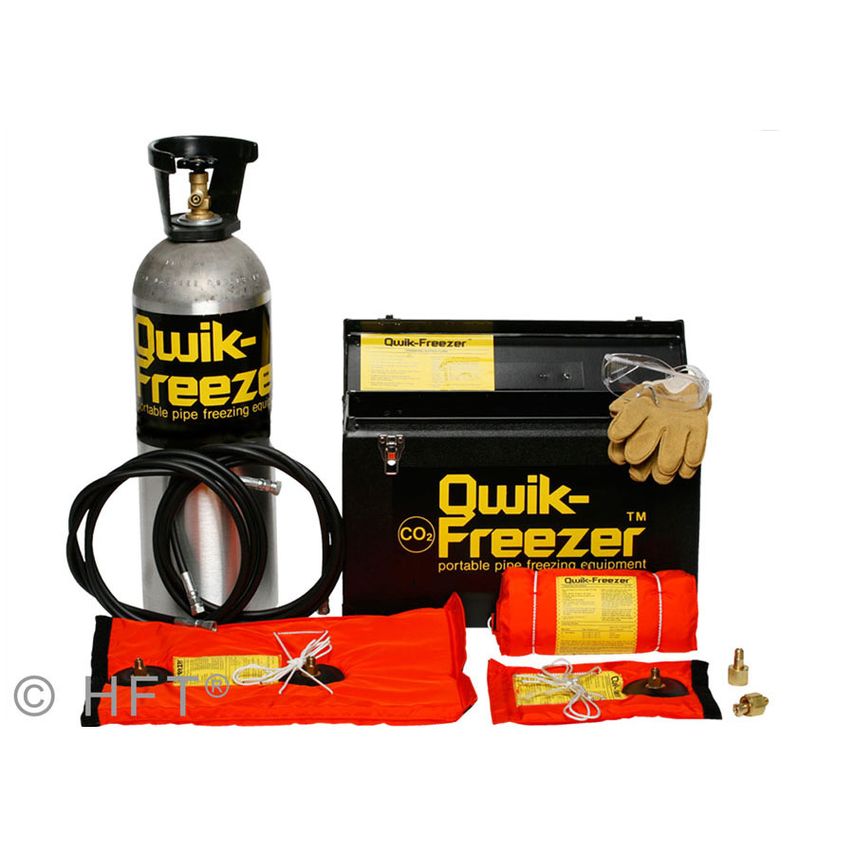Huntingdon Fusion Techniques Qwik-Freezer Portable Pipe Freezing Equipment Kit - QF3200-WOC
The HFT Qwik-Freezer Pipe Freezing Equipment employs liquid carbon dioxide (CO2) to rapidly freeze specific sections of pipe or tubing, creating a reliable ice plug with extremely low temperatures similar to dry ice. This ice plug effectively isolates the water within the system, enabling hassle-free repairs or alterations to be carried out without the need for system drainage or shutdown.
FAQs
1. How do I know how much liquid CO2 I need?
Be sure there is more than enough liquid CO2 on hand for the job (refer to the freezing table in the user instructions for the amount needed to complete the initial freeze only). If you intend to hold a freeze, extra cylinders will be needed. Use only cylinders fitted with a siphon tube or dip tube.
2. What condition does the pipe and water inside have to be in?
Ensure there is no flow of water through the pipe, as flowing water will not freeze. The outside surface of the pipe must be clean of all foreign matter. Water should be at 20C (68F) or colder. Warm water will take much longer to freeze. Always freeze on a horizontal line whenever possible. If attempting a vertical freeze, the water must be colder than 20C (68F). Additional injections and waiting time will also be necessary. A vertical pipe may take up to twice as long as a horizontal line and the CO2 consumption will be double. Do not attempt to freeze close to a main line that has flowing water as the turbulence can prevent formation of the ice plug.
3. Can I freeze pipes larger than 8 or with different material inside the pipe?
Qwik-Freezer equipment should not be used on pipes larger than the specified size or pipes containing anything but water. For other sizes and applications, contact us.
4. Will I need ventilation whilst freezing?
CO2 is heavier than air and will collect in confined and low-lying work areas. To prevent the danger of asphyxiation, make sure there is always good ventilation. Ventilation fans must be used in confined and low-lying spaces.
5. Do I need to wear safety clothing?
Gloves and safety glasses should be worn at all times when operating Qwik-Freezer equipment. Do not hold dry ice as frostbite could result.
6. Can I freeze on a weld?
It is not ideal to freeze on a weld unless the weld has been x-rayed.
7. What kind of pipes can Qwik-Freezer be used on?
Qwik-Freezer can be used on iron, lead, steel, and copper pipes. It is also applicable to plastic pipes, but these will take up to three times longer.
8. How much water pressure will an ice plug hold?
Ice plugs have passed pressure tests up to 5000 psi. HFT conservatively rates them to 1500 psi.
9. What about bursting or fracturing pipes?
Pipe fractures are not caused by the ice plug or the freezing process. They are caused by a failure to allow enough space between the ice plug and closed connections. This is due to the increase in pressure that is caused by water that is displaced by the ice plug as it grows, which can create a hydraulic ram if enough space is not allowed.
10. Why is it imperative to have CO2 cylinders with siphon tubes?
Dry ice is formed when liquid CO2 interacts with the atmosphere (which takes place inside the Qwik-Freezer jacket). If a cylinder does not have a siphon tube, it will only deliver CO2 gas, which will have no reaction. Without dry ice, there will be no freeze.
11. What if there is a small amount of glycol or other fluid in the line?
It is important to know how much is in the mix and what the freeze point of the liquid is. Note: the freeze point may just be a slush and not to the solid state that is required for a plug. The Qwik-Freezer will go down to -121F.

















































